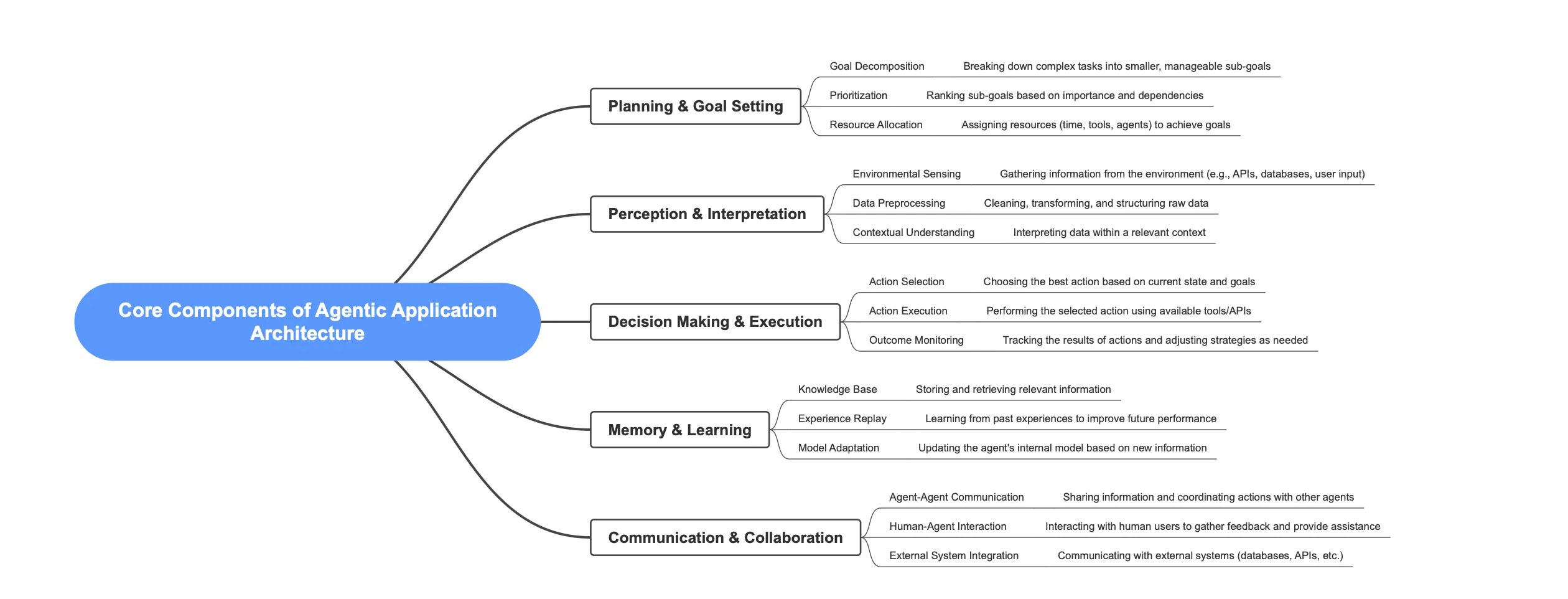Core Components of Agentic Application Architecture
Agentic Application Architecture (AAA) is a cutting-edge design paradigm that fosters the development of systems capable of autonomous decision-making and proactive interaction with their environment. This architecture underpins applications that function as “agents,” actively solving problems, anticipating needs, and dynamically adapting to contextual changes. Below are the core components that make up the foundation of this transformative architecture:

1 – Agent Layer
The agent layer consists of intelligent and autonomous units (agents) in the application. Each agent has specific roles, responsibilities, and goals, often defined by the following components:
Perception Module: Collects input from the environment (e.g., sensors, APIs, user interactions, etc.).
Reasoning Module: Analyzes input data, evaluates choices, makes decisions, and sets goals based on predefined rules or algorithms (e.g., AI models, decision trees).
Action Module: Executes tasks such as sending outputs, interacting with users, modifying the environment, or collaborating with other agents as required.
2- Communication Layer
Agents must communicate effectively to exchange information, delegate tasks, collaborate, or negotiate. Components include:
Protocols: Defines how agents communicate (e.g., REST, WebSocket, gRPC, or custom agent communication protocols).
Message Formats: Enforces standard formats like JSON, XML, etc., for structured data exchange between agents.
Broker or Middleware: Enables centralized or decentralized communication (e.g., message queues like RabbitMQ, Kafka).
3. Environment Layer
The environment is where the agents operate and interact. This layer interacts with agents to provide situational data and context.
Data Sources: APIs, databases, sensors, logs, etc., providing real-time and static input.
Rules and Constraints: Constraints on how agents operate within the environment.
Feedback Loops: Mechanisms that allow agents to perceive changes in the environment based on their actions.
4. Knowledge Base
This is the repository of structured/unstructured information used by agents for reasoning and decision-making. Examples:
Ontologies: Provides semantic understanding of data and relationships.
Machine Learning Models: Pre-trained or continuously learning models used for making predictions.
Rules Engine: A set of predefined rules dictating how agents should behave under specific scenarios.
5. Coordinator Layer (Optional)
In some systems, a high-level coordinator agent may exist to manage agents, resolve conflicts, delegate global tasks, or maintain system balance. Functions include:
Agent orchestration and task scheduling.
Monitoring the performance of agents.
Facilitating multi-agent collaboration.
Steps to Design an Agentic Application
Step 1: Define Agents
Determine what agents your system requires. For example:
User Agents: Handle user interactions.
Data Processing Agents: Analyze and transform data.
Monitoring Agents: Oversee system health and alert administrators.
Execution Agents: Carry out specific actions (e.g., connecting to APIs or performing automated workflows).
Step 2: Designing Agent Behaviors
Define the goals, rules, and constraints for each agent. Use models like finite state machines, rule-based systems, or AI-driven mechanisms to control its behavior.
Step 3: Choose Communication Protocols
Pick appropriate communication methods for agents to interact (REST APIs, Pub-Sub systems, peer-to-peer protocols).
Step 4: Architect the Environment
Identify external systems, APIs, or sensors the agents will use to gather data. Create handlers for environmental updates and other events.
Step 5: Implementation of Agents
Choose a suitable programming language or framework for building agents. Popular options include:
Python (e.g., using AI libraries like TensorFlow or PyTorch, task queues like Celery)
JavaScript/Node.js for real-time and distributed apps
AI-focused platforms like ROS (Robot Operating System) for robotics agents
Step 6: Include Feedback and Learning Mechanisms
If the agent architecture needs to adapt and improve over time, incorporate feedback loops and machine learning for continuous optimization.
Key Examples of Agentic Applications
Agentic applications can be seen in self-driving cars, recommendation systems, smart assistants, cybersecurity tools, and robotic process automation platforms, among others. Their ability to autonomously drive actions while considering user goals and adapting to environmental shifts makes them indispensable in today’s tech ecosystem.
- Environmental agents gather temperature and motion data from IoT sensors.
- Reasoning agents use the knowledge base (historical data, ML models) to decide whether HVAC systems or lights need to be adjusted.
- Execution agents interact with IoT devices to enact these adjustments.
- User agents notify occupants of actions or request input via apps.
- Agentic Application for Smart Home Control
Conclusion
The evolution of Agentic Application Architecture marks a crucial step toward highly intelligent, adaptive, and user-centric systems. By embracing autonomous behavior, contextual awareness, and proactive decision-making, this design paradigm is paving the way for impactful, futuristic applications. Developers and organizations adopting AAA principles can unlock new possibilities for enhanced efficiency, scalability, and innovation.
By understanding these core components, you can better appreciate the paradigm shifts occurring in software and systems development today—and begin harnessing them to power smarter applications of tomorrow.
